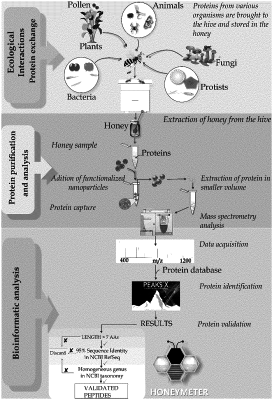| CPC C07K 1/22 (2013.01) [B01J 20/261 (2013.01); B01J 20/262 (2013.01); B01J 20/285 (2013.01); B01J 20/28016 (2013.01); B01J 20/28023 (2013.01); G01N 33/587 (2013.01); G01N 33/6848 (2013.01); G01N 2800/50 (2013.01)] | 5 Claims |

|
1. A method of assessing the risk of colony collapse disorder (CCD) in a bee hive, comprising:
contacting a honey sample obtained from the bee hive with a substrate functionalized with one or more reactive dyes;
recovering proteins associated with the substrate;
determining an amino acid sequence of the proteins; and
determining that the bee hive is at an increased risk for CCD when the amino acid sequence is from a bee pathogen or a bee stress biomarker, or
determining that the bee hive is not at an increased risk for CCD when the amino acid sequence is not from a bee pathogen or a bee stress biomarker.
|